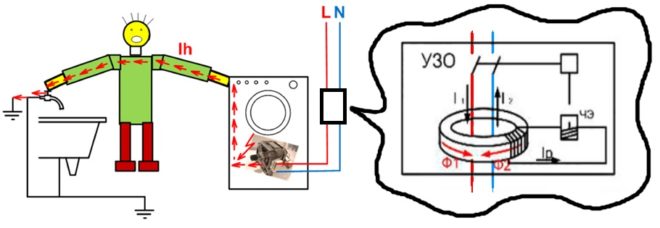Knocks out an RCD - where to look for a malfunction and repair methods

There are a large number of reasons leading to the fact that an RCD knocks out, but in general they boil down to two main ones - a malfunction of the device itself and the occurrence of current leaks in the home network. In addition, be sure to consider the possibility of incorrect installation of the device. Therefore, a competent electrician will definitely take an interest, knocks out a new RCD immediately after installation, or the device that has already worked for some time.
Content
What you need to know to identify faults
Figuratively, the operation of a residual current device can be compared with a pool, into which water enters through one pipe, and it leaves from the other. There are meters on both pipes and the work of the RCD is to monitor an equal amount of incoming and outgoing water. With an electric current, everything happens in much the same way. Each electric circuit is closed by definition - the current "enters" it through the phase, passes through all the links of the circuit and "flows" through zero. A leakage current, after which the RCD will turn off, can occur if any part of the circuit is additionally connected to an additional load or capacitance, which is the "ground" or the human body.

It is clear that the residual current device must be configured to respond only to a certain difference between the amount of incoming and outgoing "water", because "counters" cannot "spin" absolutely synchronously.
This is called the setting current, the value of which is always indicated on the device case - if the leakage is less than this value, then the RCD will not work.
Accordingly, for the device to function properly, it must be correctly connected. If, for some reason, the "pipes" are brought in incorrectly, then the "water" can directly flow between them and the RCD will not function, or the flow will "find" another path for itself and the RCD will start operating constantly, since one of the pipes will be inactive.
The principle of connecting an RCD in the video:
Why does the RCD turn off - the main reasons
All the reasons why the RCD is triggered can be divided into false ones, related to a malfunction of the device itself or its incorrect connection, and working ones - when the power supply to the circuit is turned off by the device in normal mode due to a malfunction of the electrical network or one of the electrical appliances. In each of these categories, there are main reasons to check first.

Malfunction of the RCD itself or incorrect connection
If there is no reason (clear signs) to think that the wiring or one of the electrical appliances is out of order, then first of all it is necessary to check the RCD - why it can give false alarms and is discussed below.
The mechanism of the "Test" button has deteriorated
To control the device's performance, it provides a verification mechanism - on the case there is a button with the letter "T" (or signed with the word "Test"). When it is pressed, the phase output and the zero input are short-circuited through the resistance, as a result of which a leakage current occurs and the RCD is triggered.
Here, first of all, it is necessary to understand that short-circuiting occurs with a button with normally open contacts, which can get stuck in the pressed position (dust can also adhere between them, which conducts electricity in a certain concentration).
The main symptom indicating a faulty Start button is when the RCD knocks out again when turned on - the lever turns up and immediately jumps back. But here you need to be careful, since this is exactly the same symptom as when a serious leakage of current occurs, if an insulation breakdown occurs, the current enters the body of the electrical appliance and goes to ground.
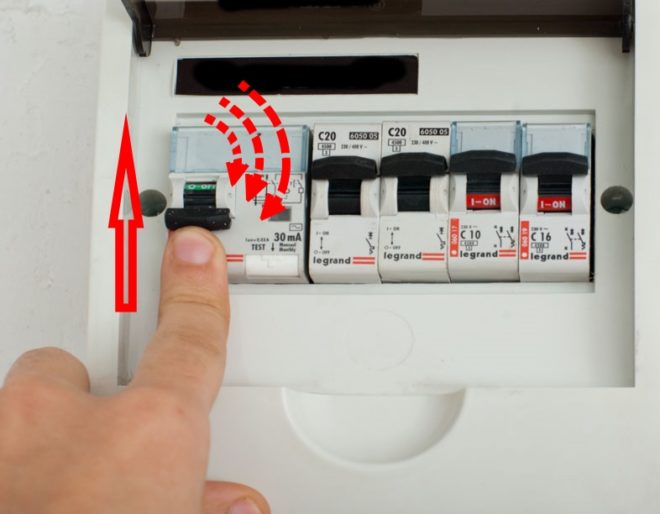
Therefore, in order to exclude the second option, all electrical appliances are disconnected from the network (from the sockets) before checking.
The lever for switching on the RCD has broken
If the residual current device can still turn on, but then spontaneously "knocks out", then not even the lever itself is likely to break, but that part of the mechanism that holds it in the on position. The fixation becomes unreliable and the lever can jump off the mount, even if the RCD is not loaded - as a result of imperceptible vibrations.
Accordingly, in order to check whether this is the reason, you just need to lightly knock on the body of the residual current device or on the lever itself - it should turn off only as a result of the application of some effort.
The occurrence of a leakage current inside the RCD case
This is a fairly rare malfunction - it can appear as a result of moisture (condensation) inside the device case. In this case, moisture can short-circuit the contacts of the "test" button or create another path for the occurrence of a leakage current.
Accordingly, the symptoms will be similar - the RCD did not turn on, so it will continue to simply throw the lever back after trying to turn it on.
First of all, attention should be paid to the possibility of condensation if the RCD is located in the open air.

Visibility of leakage current in non-standard equipment
Non-standard electrical appliances mean those that, in addition to the active component of the electric current, consume its inductive or capacitive components. These can be various kinds of flash units, as well as switching power supplies, which are used in modern computers, for chargers for mobile phones and similar gadgets.
Without going into the jungle of electrical engineering, it is enough to know that these devices use an electronic circuit that, at the moment of start-up, irrevocably takes part of the current from the network, which the RCD considers as a leak.
Incorrect connection
Everything here is simple and complex at the same time. Simplicity manifests itself in diagnostics, since a malfunction occurs immediately after any change in the electrical circuit: installing a residual current device or adding a new outlet to an existing circuit.
Examples of incorrect RCD connection diagrams in the video:
The difficulty lies in the fact that if a mistake was made, then the person conducting the installation does not have enough knowledge about the principles of operation and the connection of the residual current device and it will be quite problematic to find the cause on his own.
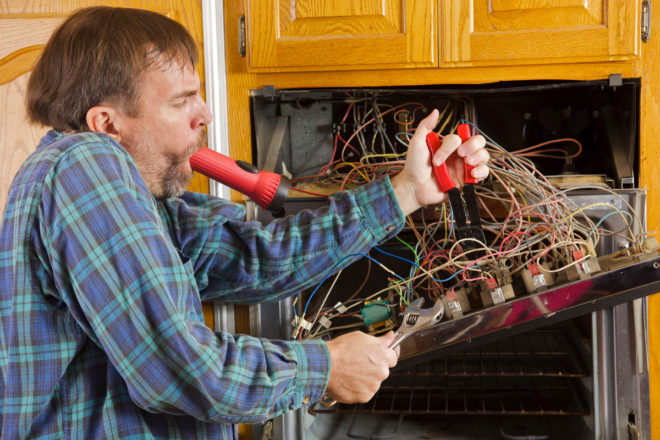
According to the masters, installation errors are the most common causes of RCD tripping among false knocks.
Normal operation of the RCD
This concept means that the residual current device has detected a real leakage current and cut off the mains power to prevent the occurrence or development of an emergency.
Current flow to the body of the electrical appliance
In a properly assembled electrical circuit according to the recommendations of the PUE, there is a mandatory grounding line, which is designed to divert the leakage current that may occur on the body of the appliance.
At the same time, it must be borne in mind that some electrical appliances have several electrical circuits.For example, if a washing machine knocks out an RCD, then this can happen either immediately when it is plugged into the network, or after a few minutes of operation - when the water heating mode is started. The same goes for, for example, a water heater.
It should be clear here that if the automation knocks out directly when the washing machine is turned on, then the matter is most likely in damage to its power cord or other wiring going to the circuit.
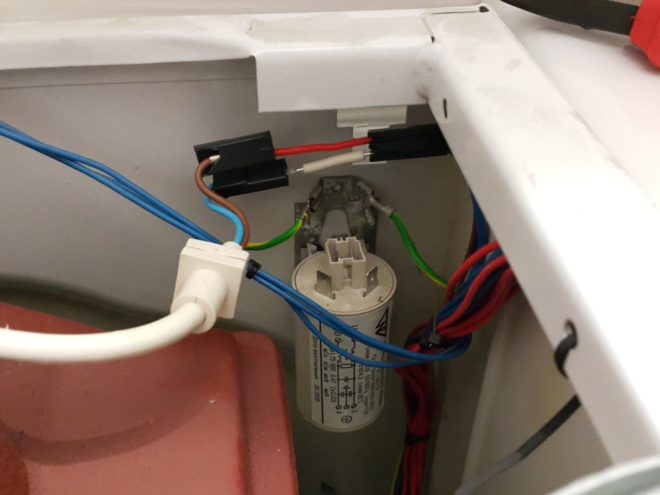
In the case of operation under load - at the time of heating, the most likely culprit is the heating element - most likely the insulation of the heating thread is broken, from it the current enters the body of the washing machine and goes to ground.
An example of repairing a washing machine, when, after turning it on, the RCD knocks out on the video:
If a person is electrocuted
It must be understood that the RCD will trip immediately after the leakage current is detected. This means that if there is a grounding and it is working properly, then in the event of a phase breakdown to the RCD case, it will not even be possible to turn it on - when the lever is lifted, it will immediately be thrown back.
If the residual current device is connected in a network without grounding, then when a phase breakdown occurs on the case, current leakage as such will not yet appear, since the current has not yet left the circuit. A leak will appear if an additional circuit is connected to the line, which is usually the human body (simply, if he touches the device body with his hand).
It should be clear that in order for the residual current device to operate, it is not necessary that a breakdown occurs on the body of the electrical appliance - even if a person simply touches the current-carrying wire, he can thereby provoke the appearance of a leakage current. At the same time, the person himself cannot always feel it - if the RCD setting is low, then the actuation will occur before the leakage current can significantly "hit".
What to do if the RCD turns off
Since the connection of the RCD is carried out strictly according to a certain scheme, the algorithm for determining the malfunction will always be approximately the same. First of all, you need to determine the reason - a false alarm occurs or, nevertheless, the shutdown is performed in the normal mode.
Here it is necessary to consider how exactly the RCD can be turned off.
- The most obvious reason is when the trips occur immediately after the installation of an RCD or an additional electrical circuit (outlet or other point). Here you just need to double-check the connection diagram and the operability of the device itself. In general, these are installation errors and it makes no sense to dwell on them in detail.
- The next case in simplicity is if there is no grounding in the house, and the person touched the body of the electrical appliance and an operation occurred. This is a direct indication of a malfunction of this device - it is necessary to revise its electrical equipment - power cord, etc.
When the RCD is connected to a network without grounding and knocks out spontaneously (without human contact with live parts of electrical equipment), then most likely this is a malfunction of the device itself.
However, if the wiring is old, then there is a small probability of contact of the phase wire with the ground, for example, with the reinforcement of the floor slab or a similar conductor. In the first case, you need to change the RCD, and in the second, all the wiring (or, at least, look for the place of damage and eliminate the malfunction).
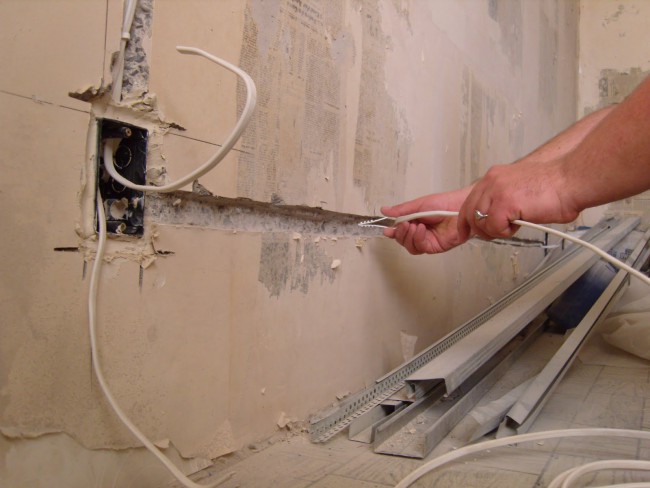
- If the RCD does not turn on after it is triggered, then first of all, you need to remove the plugs of all electrical appliances from the sockets and try to raise the device lever again. The inclusion of the RCD in the operating mode indicates the need to check all the devices - they can be plugged into the sockets one by one and then the faulty one will immediately show itself. If the RCD does not turn on further, then the wires are thrown back from its lower terminals and again they try to raise the lever. Turning on will talk about a wiring malfunction, and otherwise it is most likely a malfunction of the RCD itself.
- When a residual current device simply periodically knocks out during operation, then this is the most unpleasant breakdown in terms of diagnostics. First of all, here you need to look to see if any parameters of the electrical circuit have changed. This may be the appearance of a new device in the house, for the power of which the RCD is not designed or it has a switching power supply. If nothing has changed in the circuit, then it is necessary to monitor, after which knocks occur - this may be the operation of one of the devices in the maximum load mode, high humidity, etc. If there is no obvious reason, then you will have to consistently recheck everything possible - from the serviceability of the RCD and the correct selection of the setting to each of the links of the protected electrical circuit.

As a result, is it good or bad if an RCD is triggered
Regular tripping of RCDs, like other protective automatics, bring quite a lot of discomfort to the life of a modern person, especially if there are no obvious reasons for this in the form of melted sockets, washing with an electric washing machine, or the same incorrect operation of the boiler. The result periodically becomes the decision to temporarily disable the residual current device, but this makes sense only if the RCD itself is faulty.
Clearly about the reasons for knocking out an RCD in the video:
In order not to expose yourself to the risk of electric shock, it is advisable to know how to carry out at least an initial diagnosis of an RCD - this can be done at home and with improvised means.
Otherwise, there is an opportunity to experience the "black" adage of electricians-installers: "If it is short somewhere, then after switching on it will be immediately visible."
The point is that if the RCD reacts to a current leak through a microscopic crack (which they did not look for), then after a simple shutdown of the device, insulation will burn in its place. It is hardly worth explaining in detail what this is fraught with.
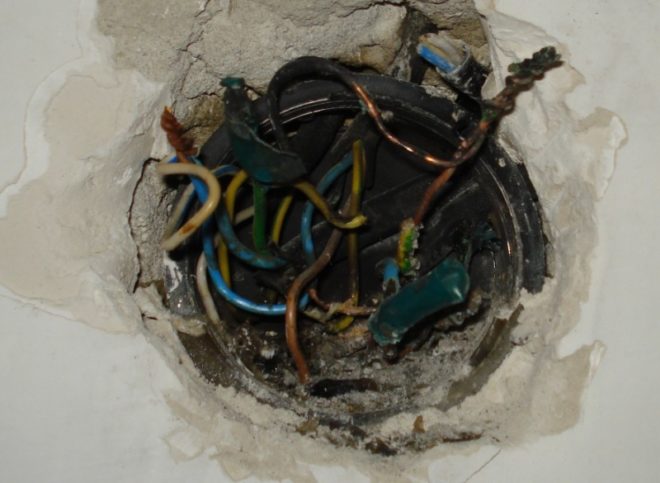
As a result, you should never spare the time to find the reason why the RCD knocks out. In any case, this is a serious reason to thoroughly review the serviceability of not only the device itself, but also the electrical circuit it protects.

